Dark wood floors whisper a promise of drama and sophistication, but they can also evoke a common fear: will they make my space feel like a closed-in, heavy cave? This apprehension often holds people back from embracing one of the most powerful design choices available.
The truth is, dark floors aren’t a limitation; they are the ultimate foundation for creating a luxuriously serene and intentional home. They provide a rich, grounding canvas that allows your furniture and decor to truly shine.
The secret to unlocking this potential lies in a strategic marriage with minimalist furniture. Minimalism, often misconstrued as cold or sterile, is actually about paring down to the essential, celebrating form, function, and exquisite materials.
When combined correctly, these two elements—the dramatic depth of dark wood and the clean lines of minimalist design—create a symphony of balance, warmth, and unparalleled elegance.
This guide moves beyond basic advice into a curated design philosophy. We present 20 distinct, MECE (Mutually Exclusive, Collectively Exhaustive) pairing strategies, systematically organized to cover every aspect of creating your perfect space. We will explore color theory, material mixing, texture play, and strategic accents to provide you with a complete blueprint for a luxe look.
The Foundational Pairings: Mastering Monochrome & Contrast
Before introducing complex materials or styles, master these core color strategies. They are the bedrock upon which all other decisions are built.
1. The High-Contrast Classic: Stark White and Unfinished Concrete

There is perhaps no more iconic pairing than deep, dark floors against pure, stark white. This is minimalism at its most graphic and powerful. The high contrast is bold and intentional, creating a clean, art-gallery atmosphere that feels both expansive and deeply grounded.
How to execute it: Think beyond just a white sofa. Imagine a kitchen with matte white lacquered cabinets and a long, raw concrete-topped island sitting proudly atop ebony floors. The coolness of the concrete and the purity of the white play against the warmth and depth of the wood, preventing the space from feeling sterile. Add a single large-scale black-and-white photograph on the wall, and the look is complete—undeniably luxe and perfectly balanced.
Pro Tip: To keep this look from feeling too clinical, ensure your whites have the same undertone. Choose a white with a slight grey or warm base to complement the floors, rather than a stark, blue-toned white.
2. The Warm Monochrome: Rich Walnut on Deep Espresso
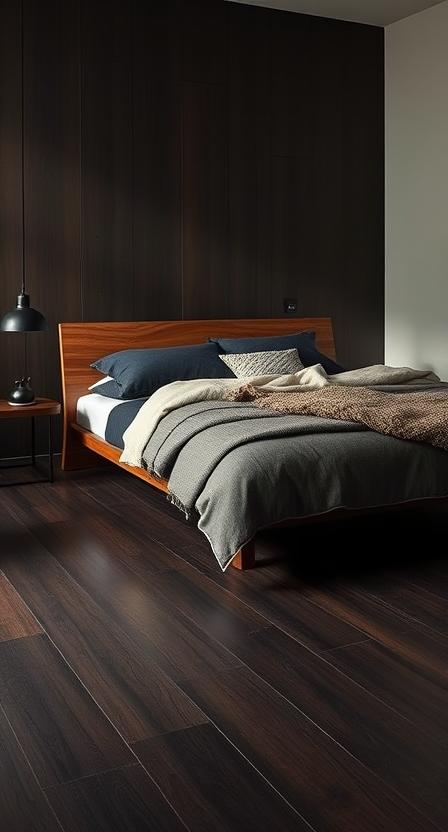
If high-contrast drama isn’t your goal, lean into the enveloping embrace of a monochromatic scheme. This approach uses similar tones to create a space that feels cohesive, deep, and incredibly sophisticated. The key is to layer tones within the same family to add depth and prevent the space from falling flat.
How to execute it: Place a mid-century modern credenza in a rich, grainy walnut atop floors stained a deep espresso. The woods are not a match, but they are cousins—close enough to feel harmonious, yet distinct enough to create visual interest. Upholster a low-profile platform bed in a warm charcoal fabric, and layer bedding in shades of oatmeal, taupe, and slate. The result is a room that feels like a cozy, modern cocoon.
Pro Tip: Incorporate varied textures like a nubby wool throw, a smooth leather chair, and matte black metal lighting fixtures to add definition within your monochromatic palette.
3. The Cool Monochrome: Charcoal and Pale Ash
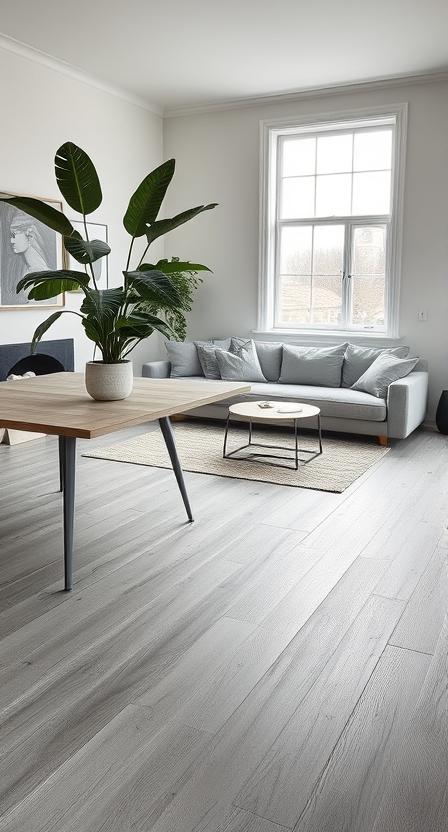
For a more Scandinavian or modern industrial feel, a cool monochrome scheme is ideal. This pairing uses gray-based woods and finishes to create a serene, airy, and slightly more detached elegance. It’s minimalist in its essence, favoring a calm and collected vibe.
How to execute it: Pair gray-washed or charcoal-stained floors with furniture made of pale ash, light birch, or even white oak with a grey oil finish. A dining table with a pale ash top and blackened steel legs would be a perfect centerpiece. Keep walls a light grey or off-white, and add textiles in shades of heather grey, soft blue, or dusty pink to introduce a touch of softness without warmth.
Pro Tip: This look thrives on natural light. Maximize window exposure and use minimal window treatments to maintain a bright, open atmosphere against the cool floor tones.
4. The Organic Neutral: Creamy Linen and Natural Jute
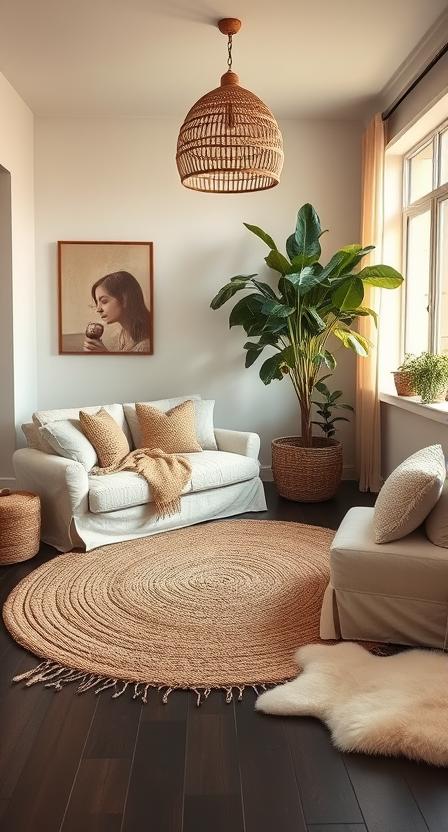
Dark floors provide the perfect anchor for organic, textural elements that make a minimalist space feel lived-in and welcoming. This strategy softens the drama of the floor with nature’s palette, creating a grounded, earthy, and effortlessly chic environment.
How to execute it: Drape a large, creamy linen slipcover over a modular sofa. Layer a natural jute or sisal rug over the dark floors—the rough texture provides a beautiful counterpoint to the smooth wood. Add a rattan pendant light, a large leafy green plant in a simple terracotta pot, and perhaps a throw in a natural sheepskin. The dark floor acts as the soil from which this organic beauty grows.
Pro Tip: Jute and sisal rugs are natural and can be rough on bare feet. Layer a smaller, softer wool or faux hide rug on top in a seating area for added comfort.
Material Alchemy: Beyond Wood-on-Wood
Once you’ve settled on your foundational color strategy, it’s time to play with materials. Mixing materials is where your personal style truly emerges.
5. Industrial Edge: Blackened Steel and Polished Nickel

Introducing metal is one of the most effective ways to add an architectural, sleek element to your space. Metals complement dark floors beautifully, enhancing the luxe factor while reinforcing a minimalist ethos through clean lines and intentional forms.
How to execute it: Incorporate a blackened steel shelving unit (think Vitsoe 606 or similar) to hold books and objects. Choose a dining table with a polished nickel base and a stone top. Use matte black metal for floor lamps and picture frames. The variety of metallic finishes—from matte black to brushed brass to polished nickel—adds layers of sophistication without visual clutter.
Pro Tip: Don’t be afraid to mix metal finishes, but stick to a rule of three. For example, use matte black for large structures, brushed brass for lighting, and polished nickel for small accents.
6. Curved Glass & Lucite: The Illusion of Space
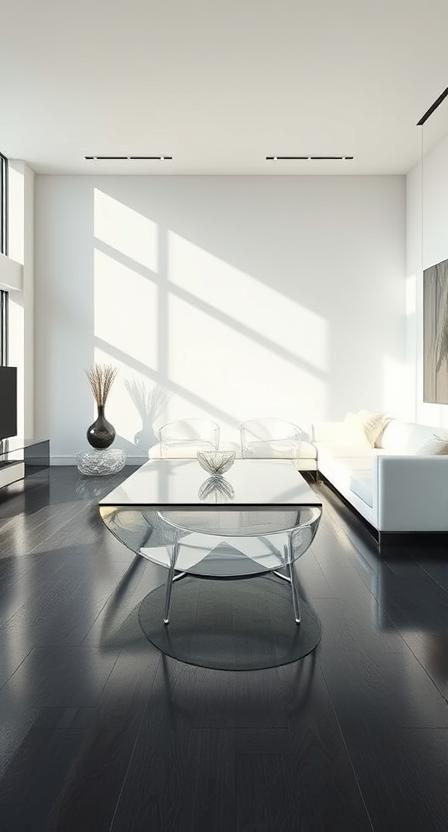
For those worried about a room feeling smaller, transparent materials are your best friend. Glass and Lucite (acrylic) maintain the minimalist aesthetic by having a near-invisible footprint, allowing the beauty of your dark floors to remain the uninterrupted star.
How to execute it: A curved glass coffee table becomes a floating sculpture, its form adding softness without heaviness. Lucite chair legs around a dining table make the chairs appear to hover. A clear acrylic console table against a wall keeps the area feeling open. These pieces respect the minimalist principle of “less is more” by virtually disappearing, creating an airy, open feel that belies the dark foundation.
Pro Tip: Keep transparent furniture clean! Smudges and dust are more visible, so a quick daily wipe-down will keep them looking their best.
7. Sumptuous Stone: Marble, Terrazzo, and Travertine
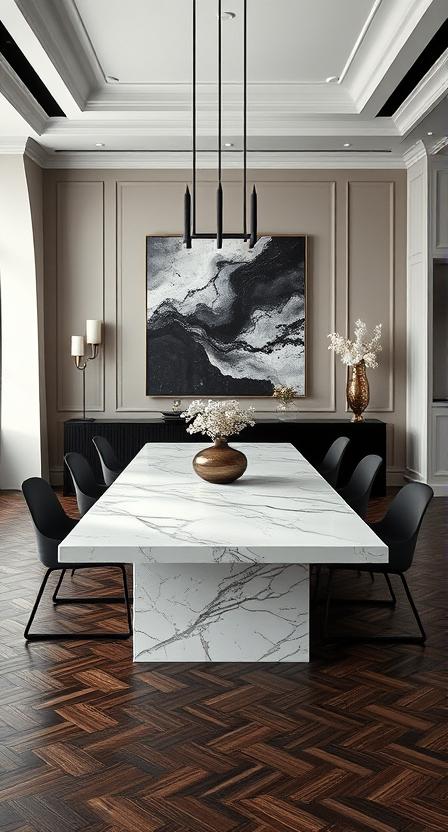
Nothing shouts luxury quite like stone. The natural, unique veining of marble, the playful speckle of terrazzo, or the porous texture of travertine introduce a timeless, organic element that pairs magnificently with dark wood. The weight of stone provides a perfect visual counterbalance to the floor.
How to execute it: Select a dining table with a solid marble top and a simple base. Use a terrazzo-topped side table next to a chair. In a bathroom, a travertine vanity sitting on dark floors is the epitome of spa-like luxury. Each piece is a functional work of art, and the dark floor acts as a stage, highlighting its unique characteristics.
Pro Tip: Stone is porous and can require sealing, especially marble, which is susceptible to etching from acids like lemon juice. Choose your stone based on the room’s function and your maintenance tolerance.
8. The Plush Factor: Velvet and Faux Fur Textiles

The final piece of the material puzzle is softness. Minimalism needs texture to feel inviting, and against hard, smooth dark floors, plush textiles create a delicious sensory contrast that is the very definition of luxe comfort.
How to execute it: Drape a deep emerald green or soft blush velvet throw over the arm of a neutral sofa. Place a faux sheepskin rug on the floor next to your bed. Upholster a statement armchair in a rich velvet. When light hits these fabrics, it creates a play of shine and shadow that adds immense depth and tactile appeal to the room, making it impossible not to sink in and relax.
Pro Tip: Velvet comes in different weights and directions of nap. Stroke the fabric both ways; the color will change slightly. Decide on a direction for upholstered pieces for a consistent look.
The Style-Specific Compositions
Now, let’s see how these pairings come together to define specific, popular minimalist aesthetics.
9. Japandi Harmony: Light Oak and Woven Textures
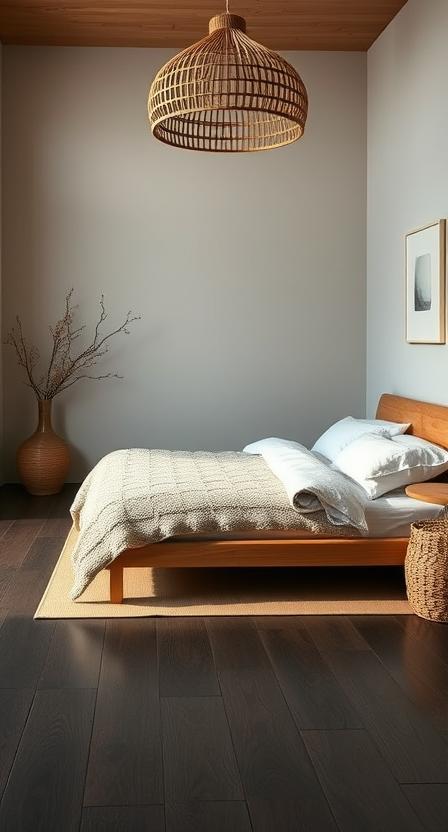
Japandi, the marriage of Japanese austerity and Scandinavian hygge, is a natural fit for dark floors. It balances minimalism with warmth, perfection with imperfection, and sleekness with texture.
How to execute it: Place a low-profile, light oak platform bed with clean lines directly on the dark floor. Layer a chunky knit blanket at the foot of the bed. Add a pendant lamp made of woven bamboo or rice paper. The dark floor grounds the light wood and airy textures, creating a zen-like atmosphere that is both simple and deeply comforting.
10. Mid-Century Modern Revival: Tapered Legs and Warm Teak
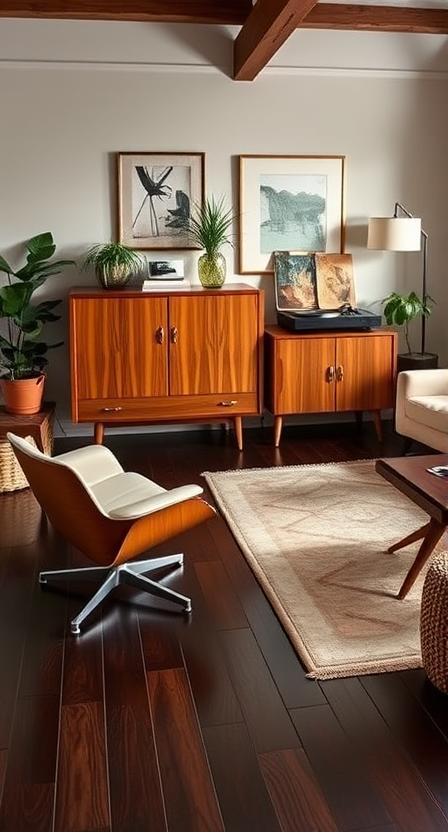
The clean lines of mid-century modern design are inherently minimalist. This style brings warmth and organic form through its use of woods like teak, walnut, and rosewood, which sing against a dark floor.
How to execute it: Choose an iconic piece like a credenza with slim, tapered legs and warm teak wood. The space between the furniture piece and the floor, created by the legs, prevents the look from feeling too heavy and allows the floor to flow underneath. Pair it with an Eames lounge chair or a sofa with a simple profile and walnut legs.
Pro Tip: Authentic vintage MCM pieces often have lighter finishes on the underside. Don’t worry if they aren’t a perfect match; the contrast adds character.
11. Organic Modern: Live-Edge Slabs and Raw Stone
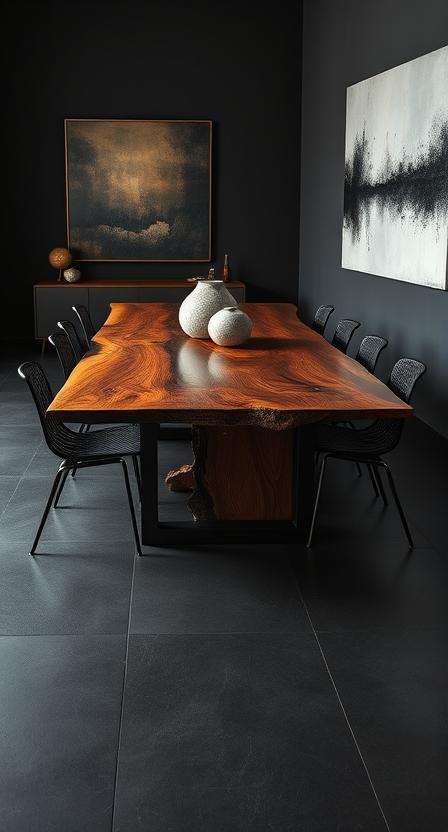
This style takes minimalism and injects a heavy dose of nature’s raw, unrefined beauty. It’s about celebrating natural imperfections, making a dark wood floor the perfect polished yet organic foundation.
How to execute it: Anchor your dining room with a single, breathtaking live-edge wood dining table. Its natural contours and unique grain pattern become the focal point. Complement it with simple chairs that don’t compete. Add accessories of raw stone, blackened steel, and perhaps a statement lighting piece made of driftwood. The dark floor frames this natural masterpiece.
12. Minimalist Glam: Brushed Brass and Smoked Glass

For those who find minimalism too stark, the “glam” infusion is the answer. It adds a layer of opulence and reflectivity that feels luxurious and decadent while still adhering to a “less is more” philosophy.
How to execute it: A coffee table with a smoked glass top and a brushed brass base catches and reflects light beautifully. Incorporate sconces with brass accents, a velvet ottoman, and a large mirror with a slim brass frame. The dark floors absorb light, while the metallic and glass elements bounce it around, creating a dynamic, sparkling effect that is undeniably luxe.
Strategic Element Pairings: Focused Applications
These are the final, crucial details that elevate a room from good to magazine-worthy.
13. Statement Seating: The Sculptural Accent Chair

In a minimalist space, every piece must earn its place. An accent chair is an opportunity to introduce a sculptural form, a pop of color, or an unexpected texture without committing to a large, overwhelming piece.
How to execute it: Choose one chair with a bold form—perhaps a curved back, an interesting woven material, or a vibrant color—and place it in a corner or next to a bookshelf. It becomes a functional art object, a conversation starter that draws the eye and adds a layer of curated personality against the dark, neutral backdrop.
14. Illumination as Decor: Strategic Floor and Table Lamps

Lighting in a minimalist dark-floored home is not just functional; it is paramount to the design. The right fixtures act as sculptures themselves, while the light they cast defines the mood and highlights key areas.
How to execute it: Select a tall, arc floor lamp to drape light over a seating area. Choose a table lamp with a solid ceramic base in a complementary color for a side table. Use adjustable picture lights to highlight art on the walls. This layered lighting approach creates pools of light and shadow, adding drama and depth and making the space feel cozy and inviting after dark.
15. Wall Harmony: From Gallery Whites to Moody Accents
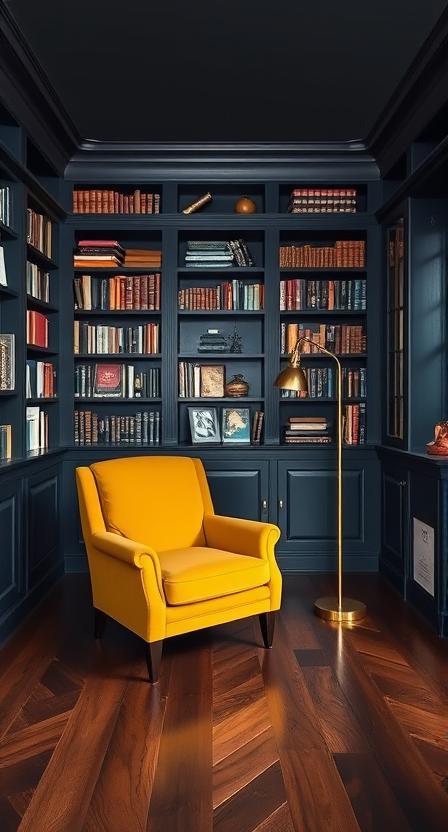
Your wall color is the largest swatch in the room and will dramatically change the relationship with your floor. You have two primary paths, both effective.
How to execute it:
- Gallery White: Light, bright walls (white, off-white, very light grey) will create the highest contrast, making your dark floors pop and defining them as a strong design element. This maximizes the feeling of space and light.
- Moody Accent: For a more cocooning, dramatic effect, paint the walls a deep, moody color like charcoal, navy, or even a dark green. This allows the floors and walls to blend, creating a seamless, enveloping capsule. Furniture in lighter tones will then appear to float within this cozy space.
16. Floor Covering as a Unifying Layer: Area Rug Strategies

A rug is essential for defining zones, adding comfort, and contributing texture and pattern. The wrong rug can disrupt the flow; the right rug will tie the entire room together.
How to execute it:
- Size: Ensure the rug is large enough. In a living room, all key furniture legs should either sit on it or just touch its edge. A too-small rug looks lost and insignificant.
- Color/Pattern: Choose a rug that complements your chosen color strategy. This could be a light, neutral jute (organic), a graphic black-and-white pattern (high-contrast), or a tonal textured weave (monochrome).
- Texture: This is your chance to add a major textural element. Shaggy wool, flat-weave cotton, nubby sisal—each will create a different feel underfoot.
Room-by-Room Application
Let’s apply these principles to specific rooms in your home.
17. The Serene Bedroom: Low-Profile Platforms and Soft Lighting

The bedroom should be a sanctuary of calm. A low-profile platform bed in a light wood or upholstered fabric sits gracefully on dark floors, promoting a sense of stability and peace. Avoid tall headboards that can feel imposing. Layer soft, neutral bedding and use warm, dimmable lighting from bedside pendants or wall sconces to create a restful ambiance.
18. The Refined Living Room: Sectional Sophistication
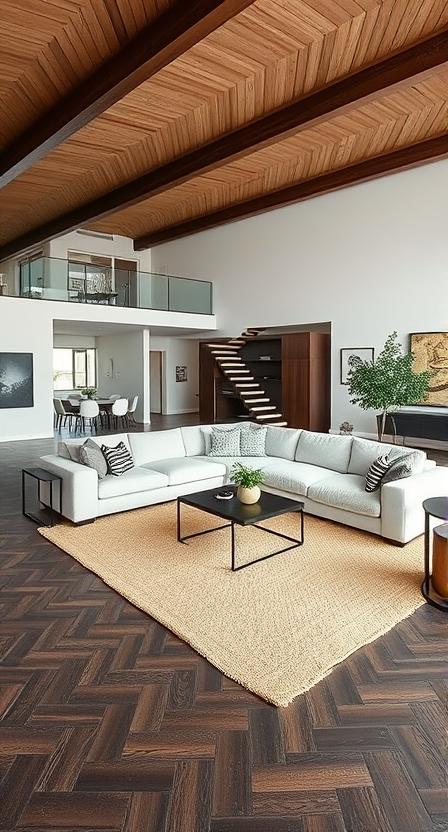
The living room needs to balance style with comfort. A low-slung, clean-lined sectional in a durable, performance fabric provides ample seating without bulk. Choose a color from your foundational strategy—white, grey, or beige. A large, light-colored area rug defines the conversation area. Use a combination of the material strategies here: a metal coffee table, a velvet armchair, and a stone-top console table behind the sofa.
19. The Elegant Dining Space: The Table as a Centerpiece
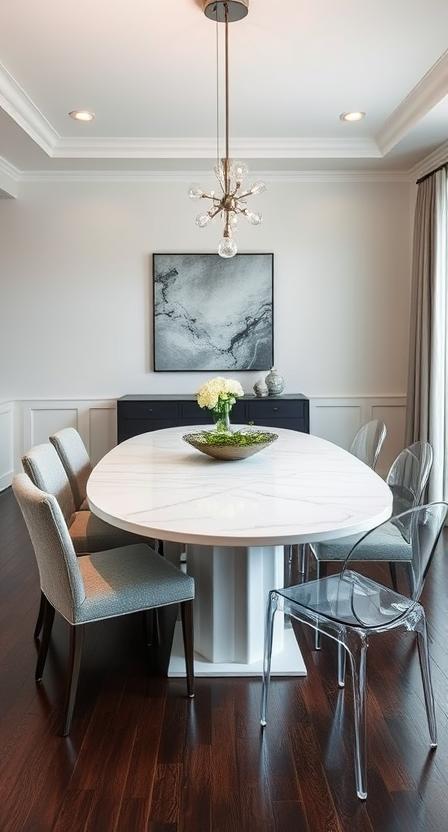
The dining table is the heart of this room. Let it be a statement piece that reflects your chosen style: a solid wood trestle table (Organic Modern), a marble-top with brass base (Minimalist Glam), or a pale ash oval table (Japandi). Surround it with chairs that complement but don’t match—perhaps a set of transparent chairs mixed with two upholstered captain’s chairs at the heads. A linear chandelier overhead completes the sophisticated gathering space.
20. The Efficient Home Office: Streamlined Worksurfaces
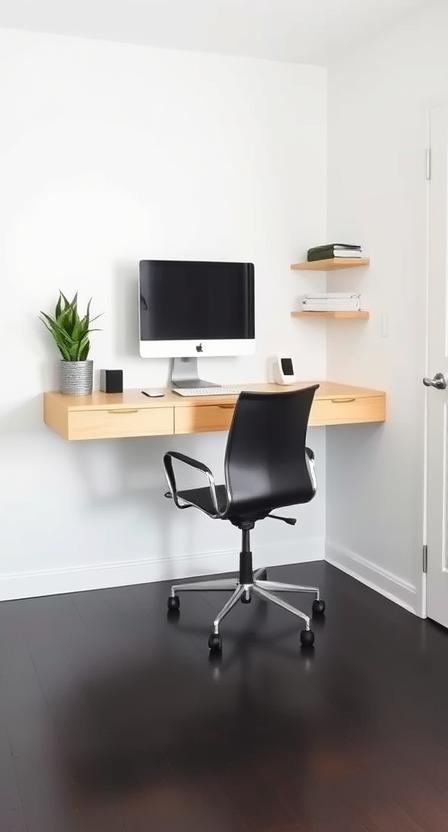
Promote focus and clarity with a minimalist home office. A wall-mounted floating desk in a light wood or white keeps the floor space completely open, making the room feel larger. Pair it with an ergonomic chair in a supportive material like mesh or black leather. Use intelligent storage—a sleek cabinet or shelving unit—to keep clutter out of sight, ensuring a clean, productive environment against your dark, grounding floors.
Summary: Synthesizing Your Luxe Look
Transforming your home with dark wood floors and minimalist furniture is not about following a single strict rulebook. It’s about understanding the principles of balance, intentionality, and harmony. The 20 pairings outlined here provide a comprehensive menu of options, from the foundational color contrasts to the finishing material touches.
Remember the core tenets:
- Balance is key: Light with dark, hard with soft, warm with cool.
- Intentionality: Every piece should have a purpose and a reason for being in the space.
- Let the floor shine: It is your foundation, your anchor, your masterpiece canvas.
Don’t be afraid to mix and match these strategies. Perhaps you love the High-Contrast Classic walls but want to bring in Sumptuous Stone and a touch of Plush Velvet. That’s how you create a space that is not only luxe and serene but uniquely and authentically yours.
Frequently Asked Questions (FAQs)
Q: Won’t dark floors make my room look smaller?
A: Not if balanced correctly. This is the most common myth. Use the strategies above: light-colored furniture on top, reflective surfaces like mirrors and glass, strategic lighting to brighten dark corners, and keeping window areas clear of heavy drapes to maintain brightness and the illusion of space. The contrast can actually define the perimeter of the room, making it feel well-structured and intentional.
Q: What is the best color for minimalist furniture on dark floors?
A: There is no single “best” color. It depends entirely on the desired effect you want to create:
White or Light Gray: For a high-contrast, modern, and airy feel.
Light Wood Tones (Oak, Ash, Walnut): For warmth, serenity, and a organic touch.
Black or Charcoal: For a bold, monochromatic, and ultra-dramatic statement.
Bold Color (Navy, Emerald Green, Terracotta): Used sparingly as an accent on a single piece of furniture to create a powerful focal point.
Q: How do I avoid my room from looking too cold or sterile?
A: The key is texture and organic elements. Minimalism becomes cold when it lacks life. Incorporate warm woods, plush textiles (wool, velvet, linen), natural fibers (jute, sisal, rattan), and organic shapes (a curved sofa, a live-edge table). Most importantly, add greenery. Large leafy plants are the easiest way to inject life, color, and a sense of vitality into a minimalist space.
Q: What type of lighting is best for rooms with dark wood floors?
A: A layered lighting scheme is non-negotiable. Relying on a single overhead light will create harsh shadows and feel cavernous. Combine:
Ambient Lighting: Recessed lights or a flush-mount ceiling fixture for overall illumination.
Task Lighting: Floor lamps next to reading chairs, under-cabinet lights in kitchens, and desk lamps.
Accent Lighting: Track lighting or picture lights to highlight art, and LED strips to wash a wall with light.
This combination creates depth, highlights features, and makes the space feel warm and inviting.
Q: Can I mix different wood tones with dark floors?
A: Absolutely. The old rule of matching woods exactly is outdated. The key is to ensure the tones are either deliberately complementary or clearly distinct enough to look intentional. For example, pairing warm walnut furniture with cool grey-toned floors creates a pleasing contrast. If the tones are close but not a match, use a large area rug or other elements like upholstery to buffer the woods and create a transition.